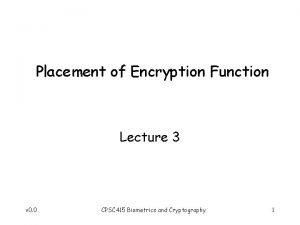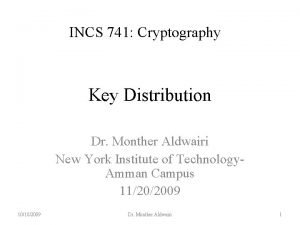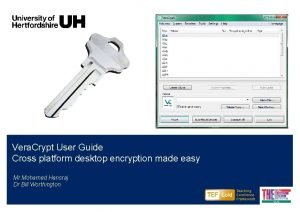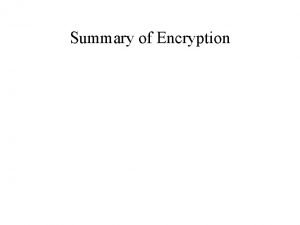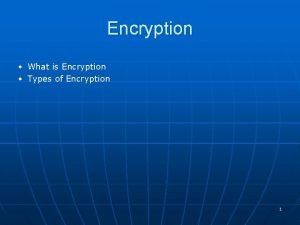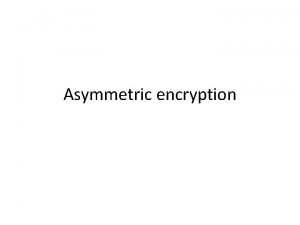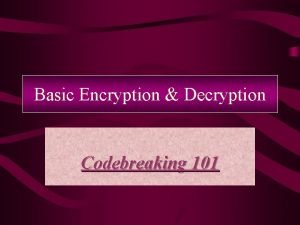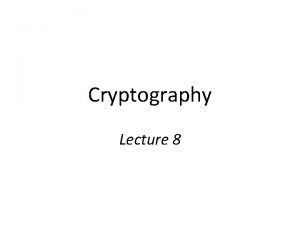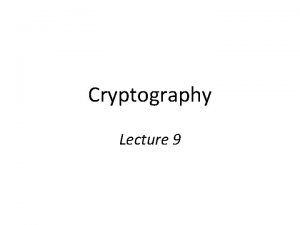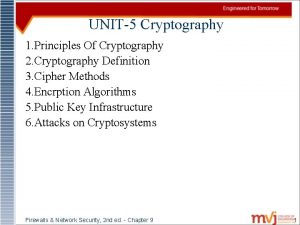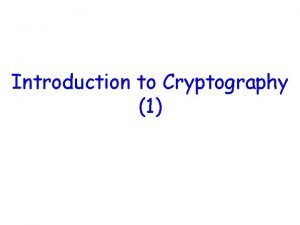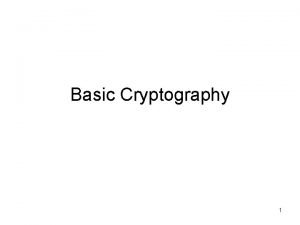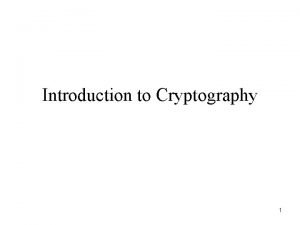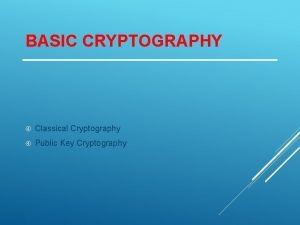The language of cryptography Alices K encryption A













































- Slides: 45


The language of cryptography Alice’s K encryption A key plaintext encryption algorithm Bob’s K decryption B key ciphertext decryption plaintext algorithm m plaintext message(明文) KA(m) ciphertext(密文), encrypted with key KA m = KB(KA(m)) 2

Simple encryption scheme substitution cipher: substituting one thing for another ◦ monoalphabetic cipher: substitute one letter for another plaintext: abcdefghijklmnopqrstuvwxyz ciphertext: mnbvcxzasdfghjklpoiuytrewq E. g. : Plaintext: bob. i love you. alice ciphertext: nkn. s gktc wky. mgsbc Key: the mapping from the set of 26 letters to the set of 26 letters 3

Breaking an encryption scheme Cipher-text only attack: Trudy has ciphertext that she can analyze Two approaches: ◦ Search through all keys: must be able to differentiate resulting plaintext from gibberish ◦ Statistical analysis Known-plaintext attack: trudy has some plaintext corresponding to some ciphertext ◦ eg, in monoalphabetic cipher, trudy determines pairings for a, l, i, c, e, b, o, Chosen-plaintext attack: trudy can get the ciphertext for some chosen plaintext 4

Types of Cryptography � Crypto often uses keys: ◦ Algorithm is known to everyone ◦ Only “keys” are secret � Public key cryptography ◦ Involves the use of two keys � Symmetric key cryptography ◦ Involves the use one key 5

Symmetric key cryptography KS plaintext message, m encryption ciphertext algorithm KS (m) KS decryption plaintext algorithm m = KS(KS(m)) symmetric key crypto: Bob and Alice share same (symmetric) key: K S � e. g. , key is knowing substitution pattern in mono alphabetic substitution cipher Q: how do Bob and Alice agree on key value? 6


ASCII码表


参考题 � 多字符表替换算法(Polyalphabetic cipher) � 例如:key: ◦ C 1=alphabate+3 ◦ C 2=alphabate+15 ◦ 代换规则,[C 1, C 2, C 1] 10


Public Key Cryptography symmetric key crypto public key cryptography requires sender, receiver know shared secret key r radically different approach [Diffie. Q: how to agree on key Hellman 76, RSA 78] in first place r sender, receiver do (particularly if never not share secret key “met”)? r public encryption key known to all r private decryption key known only to receiver 12

Public key cryptography + Bob’s public B key K K plaintext message, m encryption ciphertext algorithm + K (m) B - Bob’s private B key decryption plaintext algorithm message + m = K B(K (m)) B 13

Public key encryption algorithms Requirements: 1 . B need K+ ( ) and K- ( ) such that - + B B K (K (m)) = m 2 + given public key KB , it should be impossible to compute private key K B RSA: Rivest, Shamir, Adelson algorithm 14

Prerequisite: modular arithmetic � � x mod n = remainder of x when divide by n Facts: [(a mod n) + (b mod n)] mod n = (a+b) mod n [(a mod n) - (b mod n)] mod n = (a-b) mod n [(a mod n) * (b mod n)] mod n = (a*b) mod n � � Thus (a mod n)d mod n = ad mod n Example: x=14, n=10, d=2: (x mod n)d mod n = 42 mod 10 = 6 xd = 142 = 196 xd mod 10 = 6 15

RSA: getting ready �A message is a bit pattern. � A bit pattern can be uniquely represented by an integer number. � Thus encrypting a message is equivalent to encrypting a number. Example � m= 10010001. This message is uniquely represented by the decimal number 145. � To encrypt m, we encrypt the corresponding number, which gives a new number (the cyphertext). 16

RSA: Creating public/private key pair 1. Choose two large prime numbers p, q. (e. g. , 1024 bits each) 2. Compute n = pq, z = (p-1)(q-1) 3. Choose e (with e<n) that has no common factors with z. (e, z are “relatively prime”). 4. Choose d such that ed-1 is exactly divisible by z. (in other words: ed mod z = 1 ). 5. Public key is (n, e). Private key is (n, d). + KB - KB 17

RSA: Encryption, decryption 0. Given (n, e) and (n, d) as computed above 1. To encrypt message m (<n), compute c = m e mod n 2. To decrypt received bit pattern, c, compute m = c d mod n Magic d m = (m e mod n) mod n happens! c 18

RSA example: Bob chooses p=5, q=7. Then n=35, z=24. e=5 (so e, z relatively prime). d=29 (so ed-1 exactly divisible by z). Encrypting 8 -bit messages. encrypt: decrypt: bit pattern m me 0000 l 000 12 24832 c 17 d c 48196857210675091411825223071697 c = me mod n 17 m = cd mod n 12 19

Why does RSA work? � Must show that cd mod n = m where c = me mod n � Fact: for any x and y: xy mod n = x(y mod z) mod n ◦ where n= pq and z = (p-1)(q-1) � Thus, cd mod n = (me mod n)d mod n = med mod n = m(ed mod z) mod n = m 1 mod n =m 20

RSA: another important property The following property will be very useful later: - + B B K (K (m)) + = m = K (K (m)) B B use public key first, followed by private key use private key first, followed by public key Result is the same! 21

Why - + B B K (K (m)) + = m = K (K (m)) B B ? Follows directly from modular arithmetic: (me mod n)d mod n = med mod n = mde mod n = (md mod n)e mod n 22

Why is RSA Secure? � Suppose you know Bob’s public key (n, e). How hard is it to determine d? � Essentially need to find factors of n without knowing the two factors p and q. � Fact: factoring a big number is hard. Generating RSA keys r Have to find big primes p and q r Approach: make good guess then apply testing rules (see Kaufman) 23

RAS sample, Python � ##RAS � p=47 cipher procee � q=59 � n=p*q #prat of public and private keys � t=(p-1)*(q-1) � e=63 #part of rpivate key � d=847 #part of public key, and (e*d)%t=1 � m=244 24

� c=1 l � c=m**d%n � print "the result of 244 ciphered by RSA is " + str(c) � print "the public key: d=" +str(d)+"; n="+str(n) � print "in the process the result of m**d is " + str(m**d) � print "the anti-cipger for "+ str(c) +" is "+str(c**e % n) � print "the private key: e=" +str(e)+"; n="+str(n) � print "in the process the result of c**e is " + str(c**e) 25





ASCII码表















 Explain about the placement of encryption function.
Explain about the placement of encryption function. Classical encryption techniques in cryptography
Classical encryption techniques in cryptography Placement of encryption function in cryptography
Placement of encryption function in cryptography Hình ảnh bộ gõ cơ thể búng tay
Hình ảnh bộ gõ cơ thể búng tay Bổ thể
Bổ thể Tỉ lệ cơ thể trẻ em
Tỉ lệ cơ thể trẻ em Voi kéo gỗ như thế nào
Voi kéo gỗ như thế nào Tư thế worm breton là gì
Tư thế worm breton là gì Hát lên người ơi alleluia
Hát lên người ơi alleluia Kể tên các môn thể thao
Kể tên các môn thể thao Thế nào là hệ số cao nhất
Thế nào là hệ số cao nhất Các châu lục và đại dương trên thế giới
Các châu lục và đại dương trên thế giới Công thức tính độ biến thiên đông lượng
Công thức tính độ biến thiên đông lượng Trời xanh đây là của chúng ta thể thơ
Trời xanh đây là của chúng ta thể thơ Mật thư anh em như thể tay chân
Mật thư anh em như thể tay chân Phép trừ bù
Phép trừ bù Phản ứng thế ankan
Phản ứng thế ankan Các châu lục và đại dương trên thế giới
Các châu lục và đại dương trên thế giới Thể thơ truyền thống
Thể thơ truyền thống Quá trình desamine hóa có thể tạo ra
Quá trình desamine hóa có thể tạo ra Một số thể thơ truyền thống
Một số thể thơ truyền thống Cái miệng bé xinh thế chỉ nói điều hay thôi
Cái miệng bé xinh thế chỉ nói điều hay thôi Vẽ hình chiếu vuông góc của vật thể sau
Vẽ hình chiếu vuông góc của vật thể sau Biện pháp chống mỏi cơ
Biện pháp chống mỏi cơ đặc điểm cơ thể của người tối cổ
đặc điểm cơ thể của người tối cổ Thế nào là giọng cùng tên
Thế nào là giọng cùng tên Vẽ hình chiếu đứng bằng cạnh của vật thể
Vẽ hình chiếu đứng bằng cạnh của vật thể Fecboak
Fecboak Thẻ vin
Thẻ vin đại từ thay thế
đại từ thay thế điện thế nghỉ
điện thế nghỉ Tư thế ngồi viết
Tư thế ngồi viết Diễn thế sinh thái là
Diễn thế sinh thái là Các loại đột biến cấu trúc nhiễm sắc thể
Các loại đột biến cấu trúc nhiễm sắc thể Bảng số nguyên tố lớn hơn 1000
Bảng số nguyên tố lớn hơn 1000 Tư thế ngồi viết
Tư thế ngồi viết Lời thề hippocrates
Lời thề hippocrates Thiếu nhi thế giới liên hoan
Thiếu nhi thế giới liên hoan ưu thế lai là gì
ưu thế lai là gì Sự nuôi và dạy con của hươu
Sự nuôi và dạy con của hươu Khi nào hổ con có thể sống độc lập
Khi nào hổ con có thể sống độc lập Sơ đồ cơ thể người
Sơ đồ cơ thể người Từ ngữ thể hiện lòng nhân hậu
Từ ngữ thể hiện lòng nhân hậu Thế nào là mạng điện lắp đặt kiểu nổi
Thế nào là mạng điện lắp đặt kiểu nổi Vera krypt
Vera krypt
